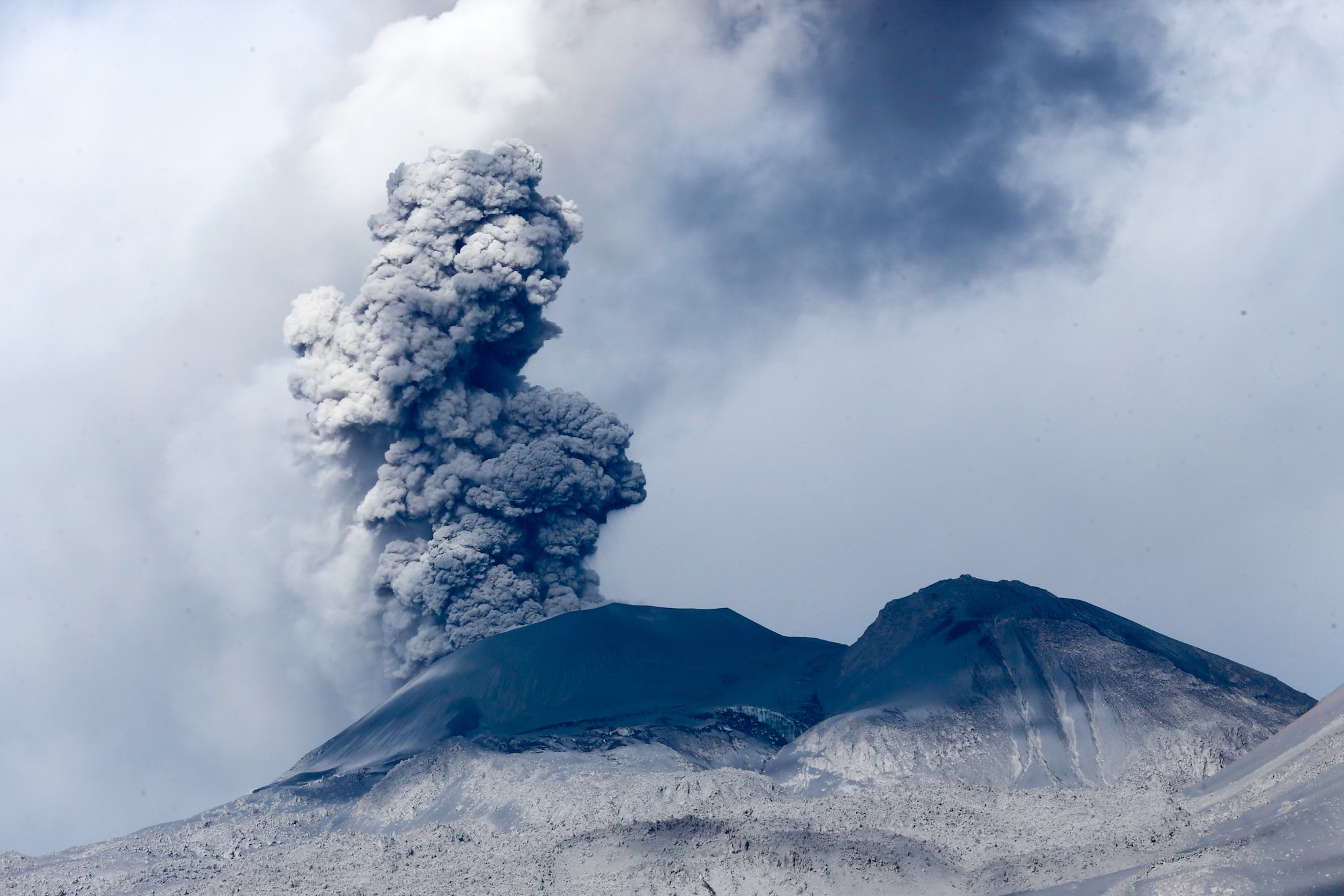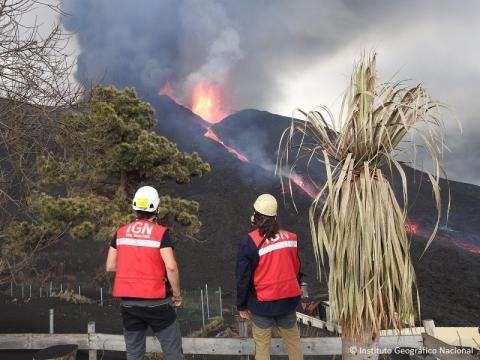1. Why are there volcanoes?
The short answer is: because the Earth is a geologically active planet.
As Civil Protection explains in its Volcanic Hazard Guide, written with volcanologists from the National Museum of Natural Sciences, “volcanoes are a surface manifestation of the Earth’s internal energy”.
The heat of the Earth's interior is due to physical and chemical processes related to the formation of the planet itself. Some of it is a remnant of the energy generated billions of years ago by the collisions of the young, still-forming planet with other bodies —the Earth is estimated to be 4.5 billion years old—. The heat also comes from the natural radioactivity of rocks in the Earth’s interior, which contain radioactive elements.
The deeper we go into the interior of the planet, the higher the temperature and pressure rise. Hundreds of kilometres down, the combined effect of temperature and pressure partially melts the rocks, which is why the mantle —from which the magma originates— is a semi-rigid layer.
The temperature gradient generates convection currents in the mantle material, which cause the tectonic plates —the blocks into which the Earth’s crust is divided— to move. The outer manifestations of activity in the Earth’s interior, such as volcanoes, are concentrated at the edges of these plates.
2. What triggers an eruption?
When magma in the mantle heats up —which can happen due to various phenomena— it becomes less dense and rises. “An eruption is the result of magma reaching the surface of the planet,” says the Volcanic Hazard Guide.
Magma can reach the surface directly from the upper mantle, at a depth of 70-100 km, infiltrating already open fractures in the crust. At other times it pauses its ascent and remains in magma chambers.
During the ascent, certain phenomena take place and these influence the eruption, such as the loss of gases that may be dissolved in the rock or the mixing in a chamber of magmas that rise in different phases.
3. Is it possible to predict when and where an eruption will occur?
As the National Geographic Institute (IGN) explains, “at present it is not possible to know exactly when and how a volcano may erupt”, although there are valuable “precursor signals” that “may indicate its next occurrence”.
4. What are the precursory signs of an eruption?
The most important are seismic activity, anomalous gas emissions and ground deformation.
However, “not all volcanoes will give the same signals, nor will all signals be followed by an eruption,” says WOVOdat, a global database of volcanic activity. “Volcanoes behave differently. Sometimes the precursor signals warn of an eruption less than an hour in advance, sometimes weeks, months or even years.”
5. How are volcanoes monitored?
The challenge is to detect the precursor signals and interpret them correctly. As the IGN explains, “at present, volcano monitoring is done by instrumentally measuring seismic activity, [ground] deformation, gas emission and anomalous temperatures”.
This information is complemented by direct observation, without specific instruments, which can reveal “noise, the appearance of fumaroles, contamination of water with volcanic gases (acidity and smell of rotten eggs), changes in the level of water wells, etc.”.
Instrumental monitoring is done mainly with seismographs —earthquakes are produced when magma breaks the ground as it rises—; with devices that measure ground deformation —such as theodolites, levels, distance meters, inclinometers— information that is also provided today by satellite images; and with chemical analysis of gases obtained from fumaroles and dissolved in water.
6. Why are some eruptions more violent than others?
2As the magma rises, it slowly cools and its composition changes, as some elements crystallise and are deposited at the bottom of the magma chamber,” explains the IGN guide. The more the magma evolves, the richer in gas it becomes. And the more gas there is in the magma, the more explosive the eruption —after all, an explosion is the result of the sudden expansion of gas; an explosive material corresponds to a chemical reaction that produces a large amount of gas in a very short time—.
Gases can make up to 5 % of the magma's weight. Sometimes the magma incorporates water from the sea or aquifers, which results in more gas. The main components of volcanic gas are: water (H2O, almost 80% of the total), carbon dioxide (CO2), sulphur dioxide (SO2) and hydrogen sulphide (H2S), and to a much lesser extent hydrogen (H2), chlorine (Cl), fluorine (F), etc.
7. What is an active volcano?
A volcano is considered active if it shows signs of activity —earthquakes, significant gas emission or an eruption— or has shown signs of activity in the last 11,700 years, the Holocene. Active volcanoes have fumaroles, i.e. emission points or an opening in the earth’s surface through which steam and other gases escape.
8.What about ‘dormant’ volcanoes?
This is the answer of IGN volcanologist Alicia Felpeto: “Sometimes in volcanology the definitions as such are more imprecise than in other fields. In general, a volcano (or a volcanic area) is considered to be active when it is expected to erupt in the future. And this is generally considered to be possible if that volcano or area has had an eruption or another manifestation of volcanic activity in the Holocene (the last 11,700 years). In contrast, an extinct volcano is one that is not expected to erupt again”.
“A dormant volcano,” Felpeto adds, “is one that can erupt (i.e. is an active volcano) but is not currently erupting; it is generally applied to those that have not erupted for a long time; but ‘long’ is completely subjective.”
9. The seven phenomena that make a volcano dangerous
The IGN identifies seven main volcanic hazards: lava flows; ash fall; pyroclastic flows; gas emissions and lahars; landslides; and tsunamis.
10. Where are there active volcanoes in Spain?
There are several volcanic areas in Spain: the Canary Islands, the region of La Garrotxa (Girona), Cabo de Gata (Almeria), Cofrentes (Valencia), the Columbretes Islands (Castellón) and Campos de Calatrava (Ciudad Real). Only in La Garrotxa and the Canary Islands have eruptions taken place in the last 10,000 years, and in historical times only in the Canary Islands —specifically in La Palma, El Hierro, Tenerife and Lanzarote—.
11. What is the Volcanic Explosivity Index (VEI)?
The VEI gives a relative measure of the explosiveness of a volcanic eruption. It can be measured in terms of the amount of material emitted and the height reached by the eruptive cloud. It is between 0 (non-explosive eruptions) and 8 (very explosive eruptions). Here is a graph illustrating this.
12. How many volcanoes are there and how often do they erupt?
There are about 1,400 active volcanoes on the planet. As the British Geological Survey explains, between 50 and 70 volcanoes erupt every year. There are 82 volcanoes in Europe and 32 of them are in Iceland. Eruptions with low VEI are much more frequent. Those with VEI 8 or higher occur every tens of thousands of years.
13. Types of explosions
Effusive: non-violent; low viscous lava, low ash production and low gas content. Explosive: violent, emission of large quantities of gas. Rock fragments, pyroclastic material and fine particles can reach more than 20 km in height.
From more to less explosive eruptions are: Hawaiian, Strombolian, Vulcanian, Sub-Plinian, Plinian, Ultra-Plinian.
To find out more
- National Geographic Institute (IGM) information material
- IGN Guide
- Educational presentation
- What to do in the event of an eruption, Civil Protection information
- Civil Defence Volcanic Risk Guide
- IGN videos
- Volcanic monitoring techniques (IGN)
- Glossary of the more common terms in an eruption




